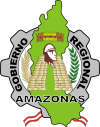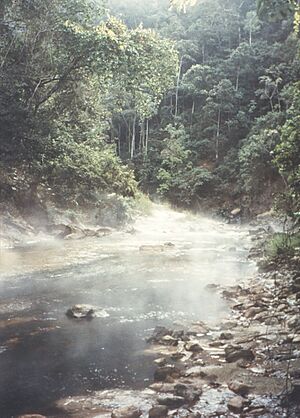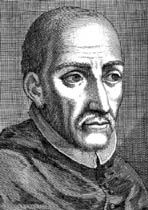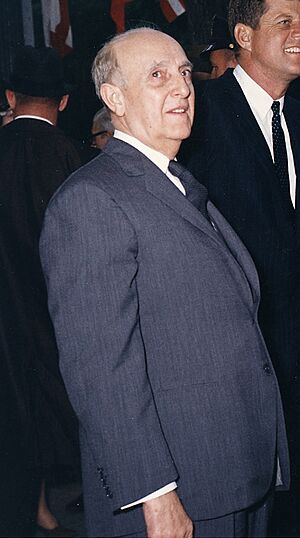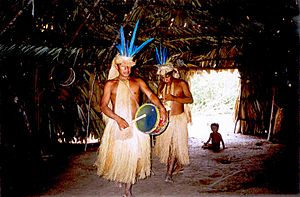Department of Amazonas, Peru facts for kids
Quick facts for kids
Department of Amazonas
|
|||
|---|---|---|---|
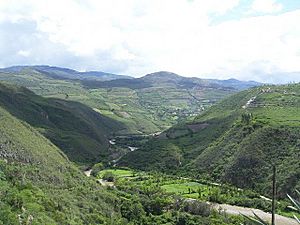
Utkupampa valley, department of Amazonas
|
|||
|
|||
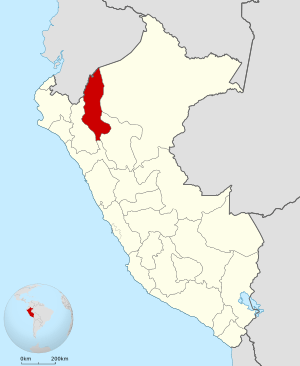
Location of the Amazonas department in Peru
|
|||
| Country | Peru | ||
| Subdivisions | 7 provinces and 83 districts | ||
| Capital | Chachapoyas | ||
| Area | |||
| • Total | 39,249.13 km2 (15,154.17 sq mi) | ||
| Elevation
(Capital)
|
2,334 m (7,657 ft) | ||
| Population
(2017)
|
|||
| • Total | 379,384 | ||
| • Density | 9.666049/km2 (25.03495/sq mi) | ||
| UBIGEO |
01
|
||
| Dialing code | 041 | ||
| ISO 3166 code | PE-AMA | ||
| Principal resources | Coffee, rice, fruits, wood and cebu cattle. |
||
| Website | www.regionamazonas.gob.pe | ||
Amazonas (Spanish pronunciation: [amaˈsonas]) is a department and region in northern Peru. It shares borders with Ecuador to the north and west. To its west is Cajamarca, to the south is La Libertad, and to the east are Loreto and San Martín. The capital city of Amazonas is Chachapoyas.
This region features steep river gorges and mountains. It is home to Kuelap, a huge stone fortress with over 400 stone buildings. Kuelap was built on a mountain about 3,000 meters high. Construction began around 500 AD and it was used until the mid-1500s. It is one of Peru's most important ancient sites.
Contents
Geography of Amazonas
The department of Amazonas has both rainforests and mountain ranges. Most of the area (about 73%) is rainforest. This rainforest extends north along the eastern slopes, reaching the border with Ecuador at the Cordillera del Cóndor mountains. The mountainous part is in the southern provinces of Amazonas. It makes up about 27% of the region's land.
One important geographical feature is that the rainforest valleys and plains are close to the Pacific Ocean. Also, the routes connecting to the coast are at low elevations. This is because they use the Paso de Porculla (Porculla mountain pass), which is only 2,144 meters high. This is the lowest pass in the entire Peruvian Andes mountains that connects to the Pan-American road system.
The wide and deep Marañón valley is a very important part of the region's landscape. The Marañón valley runs from south to north through much of Amazonas. It is widest in the Bagua province. It becomes narrower as it crosses the Eastern Mountain Range on its way east towards the lower Amazon area. Along this path, it flows through amazing canyons and natural openings called punkus. This is a Quechua word meaning "doors."
The Utkupampa valley is the main center of the Amazonas department. It is located between 5° and 6° south latitude and 78° and 79° west longitude. This valley stretches longways to the Marañón River, where it joins at 400 meters elevation.
This area is where most people live and where much of the region's production happens. It has four distinct parts:
- Marañon's Spring: This area has important streams like Seca, Bocana, Copallín Nuevo, and Choloque.
- Middle Valley: This part has eleven streams on both sides.
- High Valley: This area has seven streams, with Magunchal being the most important.
- Bagua's Plain: This area is wavy and scenic, located at 550 meters. In some places, it rises to 900 meters, like in the town of La Peca.
The main rivers that flow into the Utkupampa are the Chiriaco, the Nieva, the Santiago (which starts in Ecuador), and the Cenepa. The Cenepa River begins in the northern part of the Cordillera del Cóndor. On its journey, the Cenepa River receives many smaller rivers, like the Comaina. It eventually flows into the Marañón River near Orellana.
Plain of Bagua: Route to Huallaga Central
The Utkupampa valley starts in the high jalcas (high mountain grasslands) of the Chachapoyas Province. It flows from southeast to northwest until it meets the Marañón River, forming the large plain of Bagua. This plain has a warm climate, with temperatures reaching up to 40°C and a minimum of 21°C.
Like other parts of Peru's high jungle region, the water levels here can be unpredictable, and sometimes there are droughts. Important places along this route include the Utkupampa tourist area and Pumaqucha lake.
History of Amazonas
Archaeological digs in the rainforest show that people have lived in this area for a very long time. Many ancient cultures that thrived here are still a mystery because not much research has been done. Deep inside the region is Kuélap's Fortress, an ancient walled city and archaeological site in the mountains. It is the largest stone complex in South America, located 3,000 meters above sea level. This is even higher than the famous Machu Picchu site. Kuélap is situated above the Amazon River, where it curves before entering the wide lowland basin. This massive military structure includes the ruins of about 450 houses.
The Chachapoyas culture developed during the time of the Inca Empire. These people strongly resisted the Inca conquest. They fought off the first Inca attempts to take over their region in the 15th century.
The Spanish colonial capital of the region, Chachapoyas, was founded in 1538 by Alonso de Alvarado. Its first church was built that same year. Later, the Santa Ana, San Lázaro, and Señor de Burgos churches were also built. In April 1821, the people of Chachapoyas drove out the Spanish rulers. They followed the lead of the San Martín army, as Peru fought for independence from Spain.
The Amazonas Region played a big part in the independence movement. A priest named Toribio Rodríguez de Mendoza was a key leader. He encouraged patriots and signed the National Act of Independence.
The Cordillera del Condor, a mountain range in this region, was where a border conflict between Peru and Ecuador took place in 1981.
European Conquest
When the first Spanish explorers arrived in Amazonas, the local people welcomed them warmly. They had heard about the Spanish arrival in Peru from news that came from Cajamarca.
These people told Francisco Pizarro that Chachapoyas was a great farming region with lots of gold and silver. Pizarro quickly sent an expedition of 20 men, led by Captain Alonso de Alvarado. His order was to establish a Christian city in Chachapoyas.
Historians say that when the Spanish arrived, the Chachapoyas people held big celebrations for them. They willingly gave many valuable gifts and showed interest in becoming Christians.
Pizarro decided to send a second expedition. This time, Alvarado was instructed to officially take control of the area and found the city of San Juan de la Frontera de los Chachapoyas.
However, this time Pizarro's group faced strong resistance from a local leader called Huamán. They had to defeat him before reaching their destination. They founded the city on September 5, 1538.
Alvarado had chosen a place called Jalca, which apparently was not suitable. Because of this, the city's location was moved several times. Records show the last move was in 1544, but it's not known when the city was settled in its current spot.
European Colonization
A few years after its founding, Chachapoyas began to prosper. Magnificent buildings with large courtyards and wide halls were constructed, fitting the local style. The colonial look of Chachapoyas remains almost the same today, making it a very attractive old city.
People in this region during colonial times were very religious. The first church was built in Chachapoyas the same year it was founded. Its first priest was Hernando Gutiérrez Palacios. Later, the churches of Santa Ana, San Lázaro, and Señor de Burgos were built.
Three religious convents were also established: San Francisco, La Merced, and the Betlehemitas. Most of the people who settled in Chachapoyas were from noble families but were not rich. They lived simply and focused on agriculture and mining. Many settlers became wealthy, but they kept their simple customs, which was a key part of Chachapoyas's social life.
Over time, settlers spread to other areas, like Luya. This city was founded in 1569 by Governor Lope García de Castro. It was later confirmed by the viceroy Francisco de Toledo. In Luya, farming became diverse, and people raised dairy cows, sheep, and horses.
During one of his visits, Saint Toribio de Mogrovejo visited the main towns of this department.
Independence Movement
The people of Chachapoyas were very involved in the movement for independence. In April 1821, they supported San Martín's army. They removed the Spanish authorities, including the subdelegate Francisco Baquedano and the bishop of Maynas, Hipólito Sánchez, who were against independence.
Important patriots from Amazonas include:
- Mariano Aguilar
- Manuel Rodríguez
- Luis Zagaceta
- Lucero Villacorta
- Juan Reina
- José Fabián Rodríguez
- Dionisio Hernández
The military leader of Moyobamba, Colonel José Matos, gathered an army of 600 men. They fought the patriots on June 6, 1821, in Higos Urco pampa. Even though the patriots lacked military training, they bravely fought for their freedom. Matea Rimachi was a woman from Amazonas known as a hero of the Higos Urco battle.
Toribio Rodríguez de Mendoza, a professor, politician, and philosopher, was one of the most important patriot leaders from Amazonas. He signed the record of national independence in Lima. He was the head of the Convictorio de San Carlos and a member of the Sociedad Amantes del País (Lovers of the Country Society). He also helped start the newspaper Mercurio Peruano. He served as a representative in the Spanish Parliament and as a congressman in the first Constituent Congress. Many of its members were his students.
Republic Era
The department of Amazonas was officially created by a law on November 21, 1832. This law was proposed by two important people from Chachapoyas: Modesto de la Vega and José Braulio de Camporredondo. Camporredondo was serving as president at the time.
The same law included rules to help the new region's economy grow. For example, it removed taxes on trade with Ecuador or Brazil. According to this law, the regions of Pataz, Chachapoyas, and Maynas were part of Amazonas.
Later, the size of Amazonas was reduced. Most of its land was separated in 1866 when the department of Loreto was created.
The current provinces of Amazonas were created on these dates:
- February 12, 1821: Chachapoyas
- February 5, 1861: Luya
- December 26, 1870: Bongará
- October 31, 1932: Rodríguez de Mendoza
- September 1, 1941: Bagua
- May 18, 1984: Condorcanqui
- May 30, 1984: Utcubamba
The grand colonial look of Chachapoyas faded during the Republic. New ways of transportation made it feel isolated from the rest of the country. For over a century, Chachapoyas remained hard to reach. People had to travel by horse on long, difficult journeys from the coast, or by river from the east. This changed in 1960 when a highway reached Chachapoyas. Air travel had already started before that.
Later, during the last government of Manuel Prado, a highway was built and opened. This road connected Chachapoyas to the main Olmos-Marañon route. This finally linked Amazonas directly with Lima and the rest of Peru.
Amazonas Ancestors
The department of Amazonas has a rich ancient history that is still being explored. Its borders hold amazing archaeological sites like Cuélap, the largest ancient monument in Peru. Cuélap was the main city of the Chachapoyas culture during their most successful period.
Chachapoyas People
When the Spanish arrived in Peru in the 16th century, the Chachapoya were one of many groups that had been taken over by the Inca Empire. It was not easy for the Inca to conquer them, as the Chachapoyas often resisted the Inca troops.
The historian Pedro Cieza de León wrote about the Chachapoyas:
"They are the whitest and most handsome of all the people that I have seen in Indies, and their wives were so beautiful that because of their gentleness, many of them deserved to be the Incas' wives and to also be taken to the Sun Temple (...) The women and their husbands always dressed in woolen clothes and in their heads they wear their llautos, which are a sign they wear to be known everywhere."
Cieza also noted that after joining the Inca Empire, the Chachapoya seemed to adopt the customs of the people from the Cuzco area.
The meaning of the word chachapoya is not known. In the Quechua language, it might come from sacha-p-collas. This means "the Colla people who live in the woods."
The Chachapoya territory was very large. It included the area where the Marañón and Utcubamba rivers meet in Bagua. It stretched all the way to the basin of the Abiseo river. Here, you can find the Chachapoya's ruins of Pajatén. To the south, their land reached the Chontayacu river, which is beyond the current border of Amazonas. The heart of the Chachapoyas culture was the Utcubamba river basin.
This territory is identified by the remains of buildings in the unique Chachapoya architectural style. Garcilazo de la Vega wrote that the Chachapoyas' territory was so big that,
"We could easily call it a kingdom because it has more than fifty leagues long per twenty leagues wide, without counting the way up to Muyupampa, thirty leagues long more (...)"
(A league was a measurement of about 5 kilometers.)
The Chachapoyas area is a mountainous region that was once covered by thick tropical forests. It was called the Amazonian Andes. As the population grew, these forests were cut down to create more farmland. This led to the destruction of the rainforest and the land becoming dry. The soil was not very fertile, and many plants could not grow there. Deforestation also caused soil erosion. Today, parts of the Amazonian Andes look like the dry Andean moorlands.
The Amazonian Andes are the eastern side of the Andes mountains. They were originally covered by dense Amazonian plants. This vegetation reached very high altitudes, sometimes over 3,500 meters, where forests have not been cut down. The Amazonian Andes range from 2,000 to 3,000 meters high. This is where the Chachapoya built their settlements. Many architectural remains show they were well established here.
Before the Inca Empire
The Amazonas Region has a very old history. There are ancient rock paintings from long ago, like those in Chiñuña-Yamón and Limones-Calpón in the province of Utcubamba. Some of these paintings were made by people who hunted for food, perhaps 6,000 or 7,000 years ago. As Peruvian civilization developed, a type of pottery appeared, mainly found in Bagua.
From the Chachapoyas culture, there are countless ancient buildings. These include Cuélap, Congón (now called Vilaya), Olán, Purunllaqta (now called Monte Peruvia), and Pajatén. All these buildings show a similar style, suggesting they are related. However, we don't yet know how old these buildings are, or which ones were built first or last in the Chachapoyas culture.
Main Cultural Sites
Some of the archaeological sites that show the amazing culture of the Chachapoyas before the Inca Empire are truly incredible. These mainly include two types of burial sites and wall paintings.
Here are some of the most important archaeological sites found in the Amazonas Region:
Political Divisions
The region is divided into 7 provinces. These provinces are made up of 83 districts. The provinces and their capital cities are:
| Province | Capital | Districts |
|---|---|---|
| Bagua | Bagua | 6 |
| Bongará | Jumbilla | 12 |
| Chachapoyas | Chachapoyas | 21 |
| Condorcanqui | Sta. María de Nieva | 3 |
| Luya | Lamud | 23 |
| Rodríguez de Mendoza | Mendoza | 12 |
| Utcubamba | Bagua Grande | 7 |
Demographics
Languages Spoken
According to the 2007 Peru Census, most people in Amazonas (about 85%) learned Spanish first. Other languages spoken include native languages, especially in certain provinces. For example, in Bongará, a large number of people speak a native language other than Quechua or Aymara.
Ethnicity
Most of the people in Amazonas are Mestizo, meaning they have mixed European and Indigenous heritage (about 74%). There are also many Indigenous groups, such as the Aguaruna and Huambisa people. Other groups include White people (4.6%), Afro-Peruvians (3.5%), and Quechua (3%).
Religion
The main religion in Amazonas is Catholicism, followed by about 63% of the population. About 23% of people identify as Evangelical. Around 8% say they have no religion, and 5% follow other religions.
Literacy
In 2017, about 83% of the population in Amazonas could read and write. This means about 17% of the population was illiterate.
Folklore
The folklore of Amazonas is unique, though not as varied as in some other parts of Peru. You won't find as many different dances, songs, or traditional clothes as in places like Puno or Cuzco. Amazonas folklore is rich in legends and stories that often involve mystery and unexplained events. Towns, lagoons, hills, and religious statues often have origins that seem to go against logic or science.
For example, if you ask about the lake Quchakunka (Cochaconga), people will say it's enchanted. They believe it has the "shape of a neck." They say that the smallest noise from an animal or a person's shout can cause a huge thunderstorm. During this storm, a giant monster shaped like a cow will appear and become angry with strangers. That's why anyone passing by this remote place is very careful not to disturb the quiet.
Offering a place to stay for travelers is a basic rule of good manners. Refusing it can bring bad luck to the selfish person. A clear example is the marsh of Mono Muerto (Dead Monkey's marsh) in the Huambo District. People tell a dramatic story about it with great respect.
A very rich man lived in a house by the marsh, which was part of his land. He was happy and had everything he needed. But one day, a traveler asked for a place to stay, and the rich man refused. A witch doctor nearby heard about this. He cursed the wealthy neighbor, causing all his possessions to disappear and his land to become a smelly marsh.
Mysterious powers are also linked to the four lagoons of Pukyu. People believe monsters in these lagoons affect crops. Lake Santa Barbara is said to disappear from view and is believed to cause the end of the world if its waters overflow.
Near Chachapoyas city, there's a hill called Pisquwañuna (Piscohuañuna) on the way to the forest. Its name means "where the bird dies." This is because people believe the mountain kills any birds that come near it.
People also believe certain animals bring bad luck. The mochuelo is said to "freeze the soul." The "quien-quien" bird is thought to make fun of travelers on the roads. The cricket's singing, especially when it sounds like bells, is believed to predict big trouble.
People have great respect for ancient ruins. They strongly believe that terrible punishments will come to those who disturb the graves of the "agüelos" (mummies).
Most of the people in Amazonas are Indigenous and mestizo. There are also many communities where people have mostly Spanish features. Since the time of the Incas, there have been legends about white people living in these areas. Historians also wrote that women were chosen from here for the Inca, specifically because they were fair-skinned.
Dances
Some of the most famous dances from the Department of Amazonas are:
- The Chumaichada
- Huanca (dance)
- The Danzantes de Levanto (Levanto's Dancers)
- Carnaval en Amazonas (Carnival in Amazonas)
Religious Festivities
Religion is very important in most of these towns. People show great enthusiasm and devotion during religious celebrations. However, their religious beliefs often mix with fantastic stories and mysterious events, usually involving a cave.
Three Virgins are very famous:
- Virgen de Belén (Virgin of Bethlehem) in Chachapoyas.
- Virgen de Sonche (Virgin of Sonche)
- Virgen de Levanto (Virgin of Levanto)
Many people believe the story that all three Virgins were found in a cave. A young shepherd was mysteriously drawn to this cave. When the Virgin of Levanto visits Chachapoyas, her "sisters" are said to go to the edge of town to "receive her."
The respected image of Santa Lucía (Saint Lucy) was also found by a girl in a cave. Cristo de Bagazán (Christ of Bagazán), honored in Rioja, was found by an animal breeder looking for a lost ox. Near Almirante, he heard a voice calling his name from inside a cave. There, he found a Christ image that told him: "take me."
During long periods of drought, Cristo de la Contradicción (the Christ of Contradiction) is said to disappear from the chapel in the cemetery of Chachapoyas. He is "discovered" again when it starts to rain. Then, big celebrations begin until he is returned to his place.
Corpus Christi, Holy Week, the Assumption, Dia de los Difuntos (Day of the Dead), and Christmas are important dates in this department's calendar. During Christmas Days, groups of little shepherds walk the streets, singing and dancing in front of cribs. Patron saint festivals are celebrated with similar excitement in all towns.
One of the most well-known traditional celebrations is:
- Los pastorcillos de Navidad (Christmas's Little Shepherds)
Typical Dishes
Some of the most famous and delicious traditional dishes from this region include:
- Tamalitos
- Cazuela
- Carne arrollada (rolled beef)
- Purtumute
- Humitas de choclo (sweet tamale made of corn)
- Chipasmute
- Plátanos rellenos (stuffed bananas)
Economy
This department includes both high mountain valleys (inter-Andean) and forest regions. It has great potential for forestry and hydropower. The province of Bagua, due to its geography, is good for farming. It produces crops like rice, coffee, Cocoa bean, fruit trees, and also raises livestock.
The Amazonas department has three distinct geographical areas with different climates:
- El Cenepa District (Condorcanqui province): Has a humid tropical forest.
- Bagua Province: Has a dry tropical forest.
- Other provinces: Have very humid low mountainous forests, humid subtropical forests, and dry low mountainous forests.
The provinces of Bongará, Luya, and Chachapoyas are very hilly. They are known as the Amazonian Andes.
Amazonas mainly has an agricultural economy. It also has some mining and energy production, especially hydropower and oil. The department has excellent conditions, including good climate and plenty of pastures, for farming and raising animals.
In 1994, Amazonas had 48,173 farms. Most of these farms (99.9%) had land, while a small number (0.1%) were only for raising animals.
Agricultural Land Use
Out of the total agricultural land (about 9,750 square kilometers), only 16.4% is used for farming. The other 83.6% is non-agricultural land. This includes natural grasslands, Scrublands, and forests.
Main Crops and Farm Sizes
Farms that are 0.5 square kilometers or larger make up only 4.4% of all farms. However, they hold 61.8% of the total agricultural land.
Rice is the most important temporary crop in the department. It covers 18.5% of the land used for temporary crops. Dry yellow maize is the second most important, covering 17.9%.
For permanent crops, coffee is the most common, covering 66.4% of the land used for permanent crops. Theobroma cacao (cocoa bean) is next, covering 10.5%.
Livestock Population
Cattle are the most important livestock in the department. About 21,857 farms raise cattle, with a total of 139,267 animals. Pigs are the second most common, with 34,421 animals raised on 14,573 farms.
Climate, Rates, and Distances
| Weather | Warm, with clear rainy and dry seasons. |
| Temperature | Annual average 14.5°C |
| Road Network | 1600 km |
| Illiteracy Rate | 20% |
| Child Mortality Rate | 52 per thousand |
| Distances |
|
Culture
Organizations Linked with Amazonas
Several organizations work with the Amazon region in Peru. They help with its economic and social development and its protection. These include:
- Asociación Interétnica de Desarrollo de la Selva (AIDESEP) – Interethnic Association for the Rainforest Development
- Centro Amazónico de Antropología y Aplicación Práctica (CAAAP) – Amazon Center of Anthropology and Practical Application
- Instituto Lingüístico de Verano – Linguistic Summer Institute
Notable People from Amazonas
- Blas Valera
- Toribio Rodríguez de Mendoza
- Manuel Antonio Mesones Muro
- José del Carmen Marín
Places of Interest
- Cordillera de Colán Reserved Zone
- Ichigkat Muja – Cordillera del Condor National Park
- Santiago-Comaina Reserved Zone
- Gocta Cataracts
See also
 In Spanish: Departamento de Amazonas (Perú) para niños
In Spanish: Departamento de Amazonas (Perú) para niños
- Amazonas State, Venezuela
- Amazonas State, Brazil
- Amazonas before the Inca Empire



